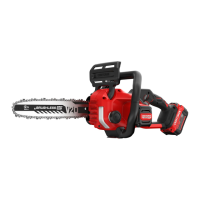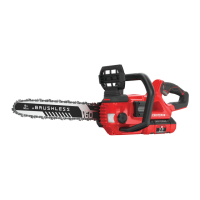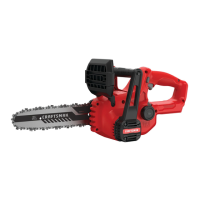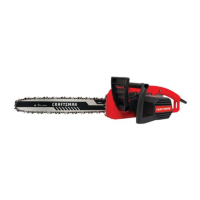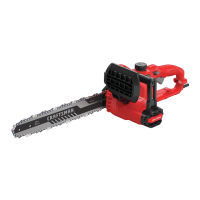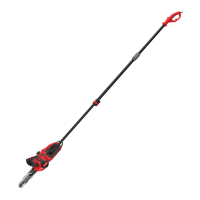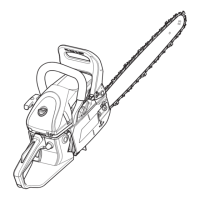ENGLISH
8
f ) Always keep proper footing and operate the chain
saw only when standing on fixed, secure and level
surface. Slippery or unstable surfaces may cause a loss
of balance or control of the chainsaw.
g ) When cutting a limb that is under tension, be
alert for spring back. When the tension in the wood
fibers is released, the spring loaded limb may strike the
operator and/or throw the chain saw out ofcontrol.
h ) Use extreme caution when cutting brush and
saplings. The slender material may catch the
saw chain and be whipped toward you or pull you
offbalance.
i ) Carry the chain saw by the front handle with
the chain saw switched off and away from your
body. When transporting or storing the chain saw
always fit the guide bar scabbard. Proper handling
of the chain saw will reduce the likelihood of accidental
contact with the moving sawchain.
j ) Follow instructions for lubricating, chain
tensioning and changing the bar and chain.
Improperly tensioned or lubricated chain may either
break or increase the chance forkickback.
k ) Cut wood only. Do not use chain saw for purposes
not intended. For example: do not use chain
saw for cutting plastic, masonry or non‑wood
building materials. Use of the chain saw for
operations different than intended could result in a
hazardoussituation.
l ) Do not attempt to fell a tree until you have an
understanding of the risks and how to avoid
them. Serious injury could occur to the operator or
bystanders while felling atree.
m ) Follow all instructions when clearing jammed
material, storing or servicing the chain saw.
Make sure the switch is off and the battery pack
is removed. Unexpected actuation of the chain saw
while clearing the jammed material or servicing may
result in serious personal injury.
n ) Do not operate a chain saw in a tree unless you
have been specifically trained to do so. Operation
of a chain saw in a tree without proper training could
increase the risk of serious personal injury.
Causes and Operator Prevention
ofKickback:
Kickback may occur when the nose or tip of the guide bar
touches an object, or when the wood closes in and pinches
the saw chain in thecut.
Tip contact in some cases may cause a sudden reverse
reaction, kicking the guide bar up and back towards
theoperator.
Pinching the saw chain along the top of the guide bar may
push the guide bar rapidly back towards theoperator.
Either of these reactions may cause you to lose control of the
saw which could result in serious personal injury. Do not rely
exclusively upon the safety devices built into your saw. As a
chain saw user, you should take several steps to keep your
cutting jobs free from accident orinjury.
Kickback is the result of tool misuse and/or incorrect
operating procedures or conditions and can be avoided by
taking proper precautions as given below:
a ) Maintain a firm grip, with thumbs and fingers
encircling the chain saw handles, with both hands
on the saw and position your body and arm to
allow you to resist kickback forces. Kickback
forces can be controlled by the operator, if
proper precautions are taken. Do not let go of the
chainsaw.
b ) Do not overreach and do not cut above shoulder
height. This helps prevent unintended tip contact
and enables better control of the chain saw in
unexpectedsituations.
c ) Only use replacement bars and chains specified
by the manufacturer. Incorrect replacement bars and
chains may cause chain breakage and/orkickback.
d ) Follow the manufacturer’s sharpening and
maintenance instructions for the saw chain.
Decreasing the depth gauge height can lead to
increasedkickback.
The Following Precautions Should Be
Followed to Minimize Kickback:
1 . Grip saw firmly. Hold the chain saw firmly with both
hands when the motor is running. Use a firm grip
with thumbs and fingers encircling the chain saw
handles. Chain saw will pull forward when cutting on the
bottom edge of the bar, and push backward when cutting
along the top edge of thebar.
2 . Do not overreach.
3 . Keep proper footing and balance at alltimes.
4 . Don’t let the nose of the guide bar contact a log,
branch, ground or otherobstruction.
5 . Don’t cut above shoulderheight.
6 . Use devices such as low kickback chain and reduced
kickback guide bars that reduce the risks associated
withkickback.
7 . Only use replacement bars and chains specified by
the manufacturer or theequivalent.
8 . Never let the moving chain contact any object at the
tip of the guidebar.
9 . Keep the working area free from obstructions such
as other trees, branches, rocks, fences, stumps, etc.
Eliminate or avoid any obstruction that your saw chain
could hit while you are cutting through a particular log
orbranch.
10 . Keep your saw chain sharp and properly tensioned.
A loose or dull chain can increase the chance of
kickback. Check tension at regular intervals with the
motor stopped and tool unplugged, never with the
motorrunning.
11 . Begin and continue cutting only with the chain
moving at full speed. If the chain is moving at a slower
speed, there is a greater chance for kickback tooccur.
12 . Cut one log at atime.
